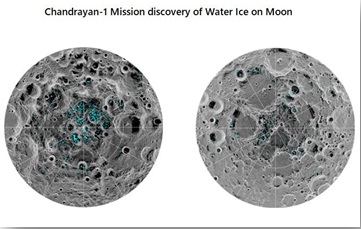
|
Syllabus: Prelims GS Paper I: Current Events of National and International Importance; General Science. Mains GS Paper III : Awareness in the fields of IT, Space, Computers, Robotics, Nano-technology, Bio-technology and issues relating to Intellectual Property Rights. |
Context
NASA discovers water on sunlit surface of the Moon.
NASA's Stratospheric Observatory for Infrared Astronomy (SOFIA) has detected water molecules (H2O) in Clavius Crater, one of the largest craters visible from Earth, located in the Moon’s southern hemisphere. This discovery indicates that water may be distributed across the lunar surface.
NASA in its report said the molecules discovered are equivalent to a twelve-ounce bottle of water within a cubic meter of lunar soil. The water likely arrived at the Moon via one of two ways. It may have been carried there by radiation known as the solar wind, or on tiny meteorites.
Significance of the Discovery
Water is a primary and essential unit of life. Its presence refelects the huge potential for life on moon, simultaneously it is a precious resource in deep space. For astronauts landing on the Moon, water is necessary not only to sustain life but also for purposes such as generating rocket fuel. NASA’s Artemis programme plans to send the first woman and the next man to the Moon in 2024, and hopes to establish a sustainable human presence, there, by the end of the decade. If space explorers can use the Moon’s resources, it means they need to carry less water from Earth.
Previous Studies for Water on Moon
The Indian Space Research Organisation’s (ISRO) Chandrayaan-1 mission, have provided significance evidence for the existence of water. The Moon Mineralogy Mapper (M3) instrument aboard Chandrayaan-1 found water molecules in the polar regions. A paper in Nature Geoscience In August 2013 analysed M3 data to report the detection of magmatic water (water originating from the deep interiors) on the Moon’s surface.
Exact and reliable facts were not established in such studies. In the last studies based on the observations by the Chandrayaan-1 mission, NASA’s Cassini and Deep Impact comet mission, and NASA’s ground-based Infrared Telescope Facility, primary question still exist that whether the detected molecules were water as we know it (H2O) or in the form of hydroxyl (OH).
But this time, it is confirmed H20 molecules, discovered in Clavius Crater in the Moon’s southern hemisphere. It is the first time water has been detected on the sunlit side, showing it is not restricted to the shadowy regions.
SOFIA, which is a modified Boeing 747SP jetliner that flies at altitudes up to 45,000 feet, has an infrared camera that picked up the wavelength unique to water molecules. The data showed water in concentrations of 100-412 parts per million trapped in 1 cubic metre of soil.
SOFIA’s mission is to look at dark and distant objects. The Moon, on the other hand, is so close and bright that it fills the SOFIA guide camera’s entire field of view. In August 2018, just to check whether SOFIA could reliably track the Moon, scientists tried a test observation. It was from this test that came the detection of water. Scientists are now planning more observational flights.
Water Existence on Moon
Space rocks carrying small amounts of water could have bombarded the Moon. Alternatively, the Sun’s solar wind could have carried hydrogen, which then reacted with minerals in the lunar soil to create hydroxyl, which later transformed into water.
The sunlit surface retaining the water presents a puzzle, since the Moon does not have a thick atmosphere. One possibility is that the water gets trapped into tiny bead like structures that were created in the soil by impacts from space rocks. Alternatively, the water could be hidden between grains of lunar soil and sheltered from the sunlight.
Accessibility
On the sunlit side, it is not yet known whether the water SOFIA found is easily accessible. On the other hand, the hidden, shadowy pockets on the lunar surface called cold traps are spread across a combined 40,000 sq km, the other study has reported. That is roughly the size of Kerala.
The estimate used mathematical tools to analyse data from NASA’s Lunar Reconnaissance Orbiter. The cold traps have gone without sunlight for potentially billions of years. If they do contain ice, it means water is going to be more accessible than previously assumed.
Conclusion
Further observations would help better understand where the water may have come from and how it is stored.
SOFIA will look for water in additional sunlit locations to learn more about how the water is produced, stored, and moved across the Moon. Meanwhile, NASA’s Volatiles Investigating Polar Exploration Rover (VIPER) will carry out a mission to create the first water resource maps of the Moon.
Connecting the Article
Question for Prelims: Artemis program, is recently in news, in the context of
(a) Corona Virus vaccine
(b) Space Mission
(c) WTO
(d) European Union
Question for Mains: NASA has achieved remarkable success by discovery of water on moon surface, although India's Chandrayaan-1 mission earlier also revealed this fact. How the present discovery is different from the earlier discoveries? Explain.

Our support team will be happy to assist you!
